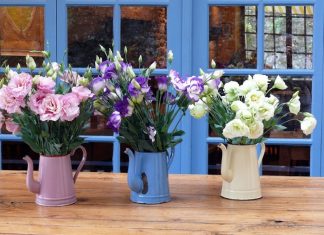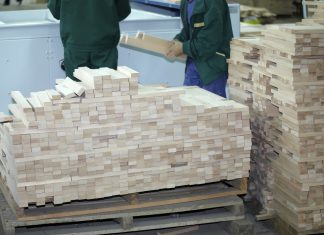Who would’ve thought someone could become a celebrity by teaching people how to clean? But Marie Kondo did just that, tidying her way into our hearts with her book, The Life-Changing Magic of Tidying Up, and its accompanying Netflix series.
Her method, known as KonMari, has a strong and simple core. Kondo has six basic rules that anyone can apply to their dwelling place, whether it’s a condo, apartment, duplex or single-family home. And while she recommends applying them together and in order for best results, each one has something broadly applicable to teach all by itself.
This guide will give you a quick intro to the popular cleaning and organizing method that many people credit with transforming the way they live at home. Get your garbage bags and other cleaning essentials ready and start letting go of clutter and living your best life!
 1. Make a personal commitment to creating a tidy space.
1. Make a personal commitment to creating a tidy space.
Kondo’s first rule recognizes the importance of mindset in getting things done. Before you start your tidying project, think about why you’re doing it and make a commitment to seeing it through all the way. Plan the basic outline of the process all the way through to the end, if possible.
This might seem like a small thing, but establishing the commitment does make a difference for many people. It starts with clear intention that leads to action. Kondo emphasizes that her method isn’t a quick fix. It’s a continual process for refining your lifestyle and your relationship to the objects in your living space. Whatever method you’re using in your space, make sure that commitment and planning are a part of it.
2. Imagine your space, organized for the lifestyle you want.
Everyone’s got their own idea of the good life, and the organization of your space should reflect that. Maybe football Sundays are the highlight of your week, or maybe your reading nook is your happy place. Think about these things that you love so much about your life and then imagine a lifestyle that encourages them.
The point of this imaginative exercise is to clarify what a tidy life looks like to you. A tidy lifestyle makes it possible to do more of the things that bring you joy. This is also a good time to note that, in a shared living space, any tidying process requires respect for other people’s belongings, too. Don’t touch them unless you have their permission. Your joy shouldn’t interfere with other people’s!
3. Start by discarding.
The next tip is to begin each phase of your cleaning process with discarding. KonMari makes this a time for reflection, including thinking about what lessons you’ve learned from anything that you’re throwing away. Ask yourself what you can learn, whether that’s “this brand isn’t very good,” “I don’t need an umbrella this big” or “I need to buy compatible trash bags next time.”
Kondo’s discarding method includes some ceremonial aspects, especially for sentimental objects. This can be a soothing and enjoyable experience for someone who wants to go full KonMari, but whether or not you do it, remember to start your tidying with a thorough discarding process.
4. Use categories, rather than locations, to guide your tidying.
You might have cleaned your front hallway a hundred times and even come up with an organizational system for it, but it always seems to be dirty again tomorrow. Why is that? According to Kondo, this is because tidying by location in your home is a surefire path to clutter and chaos.
Instead, she strongly advocates tidying up using five categories of items: Clothes, books, papers, komodo (miscellaneous items) and sentimental things. Kondo also recommends following these categories in order for best results. But no matter what order you go in, the message is that a systematic approach to cleaning and organizing will provide a better outcome.
5. Start with easier categories.
Why is it that Kondo so strongly recommends tidying in her specific category order? Partially, you’re going for a self-motivation effect. Seeing your results will help fuel your drive to finish the rest of the process. But, if you’re doing proper KonMari cleaning, the additional advantage of this method will be to refine your understanding of your own feelings and preferences.
The lesson here is to give yourself some early wins and generate some momentum. Starting with clothes is a great idea because you probably know when you never wear something. Just as importantly, however, this progress does eventually build toward more difficult challenges, like the final stage of releasing even sentimental items. In other words, make sure that the easy wins build up to the big ones.
6. When in doubt, ask: Does it spark joy?
Kondo’s most famous rule is the question “Does it spark joy?” It’s a simple test that can help you cut through the indecision about whether or not to keep something. Moreover, it’s a core philosophical principle of KonMari that will help you understand why the whole method works.
The idea is to fill your space, not just with objects, but with objects that make you happy. Objects that, in the words of Marie Kondo, give you a feeling as if “the cells in your body are slowly rising.” This feeling often can’t be put exactly into words or numbers, but the point is to listen to your deepest emotions about the things in your home.
That doesn’t mean, of course, that you should toss out your hand soap or trash bags because they don’t “spark enough joy.” It’s a question that’s best suited to non-essentials, although no one’s stopping you from getting (for example) colored trash bags to introduce some joy into the mundane!
Almost anyone can learn some important principles of cleaning from the principles Kondo has popularized. Keep these tips in mind when you clean and organize, and watch your life start to tidy itself up — little by little!

 1. Make a personal commitment to creating a tidy space.
1. Make a personal commitment to creating a tidy space.














